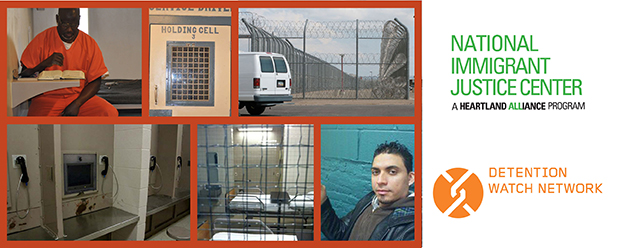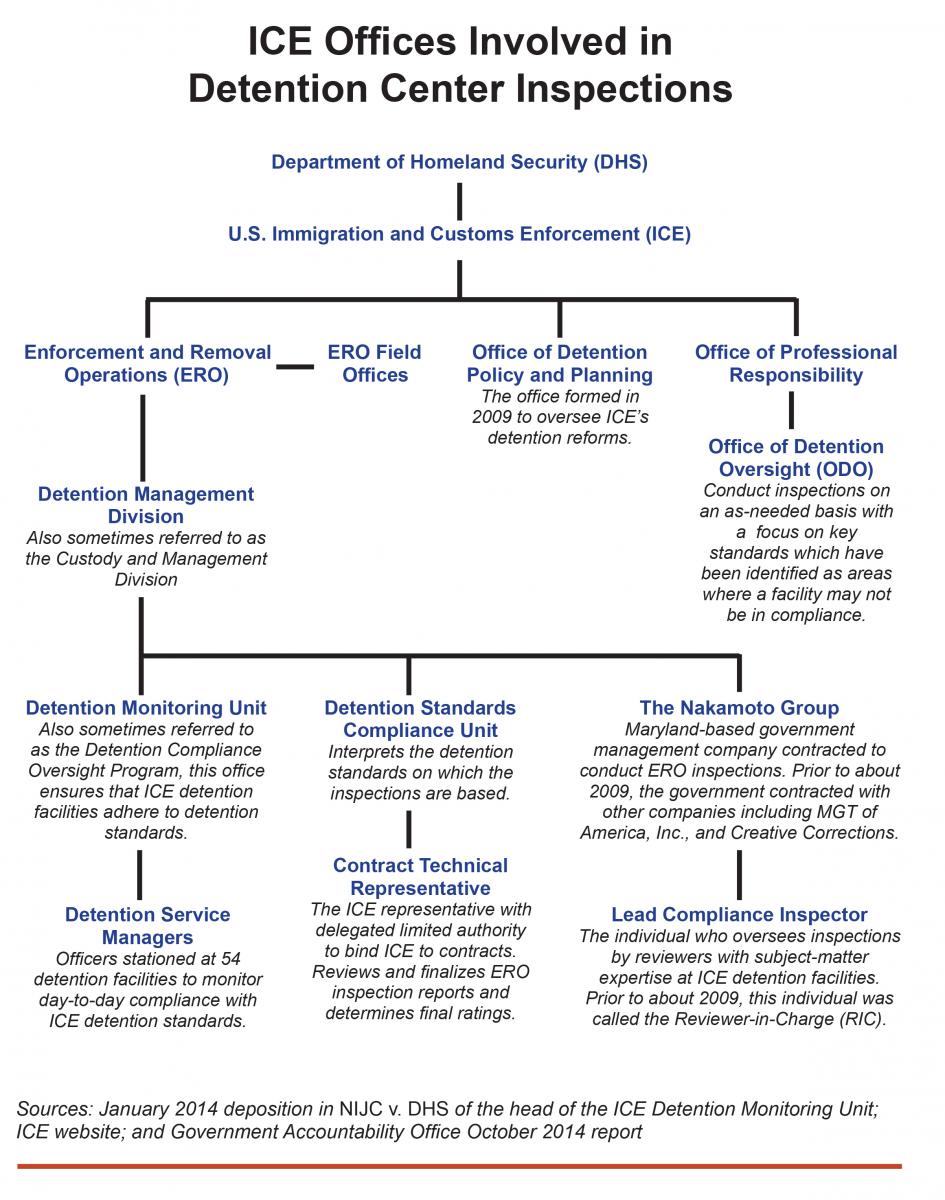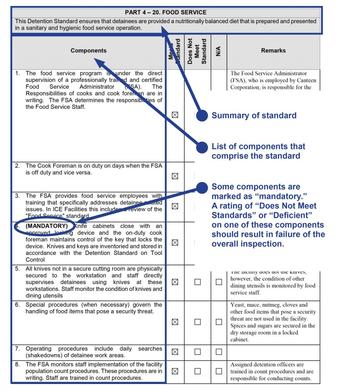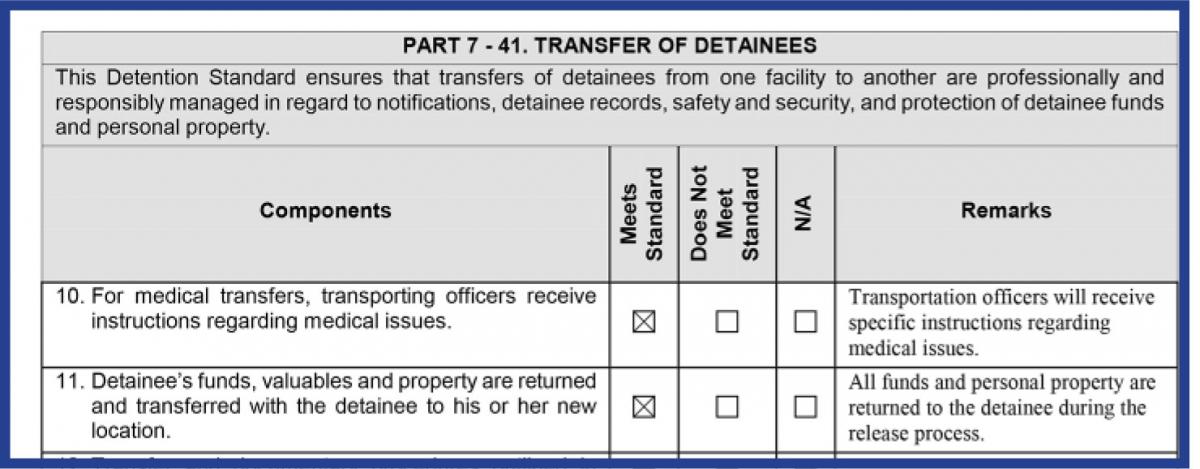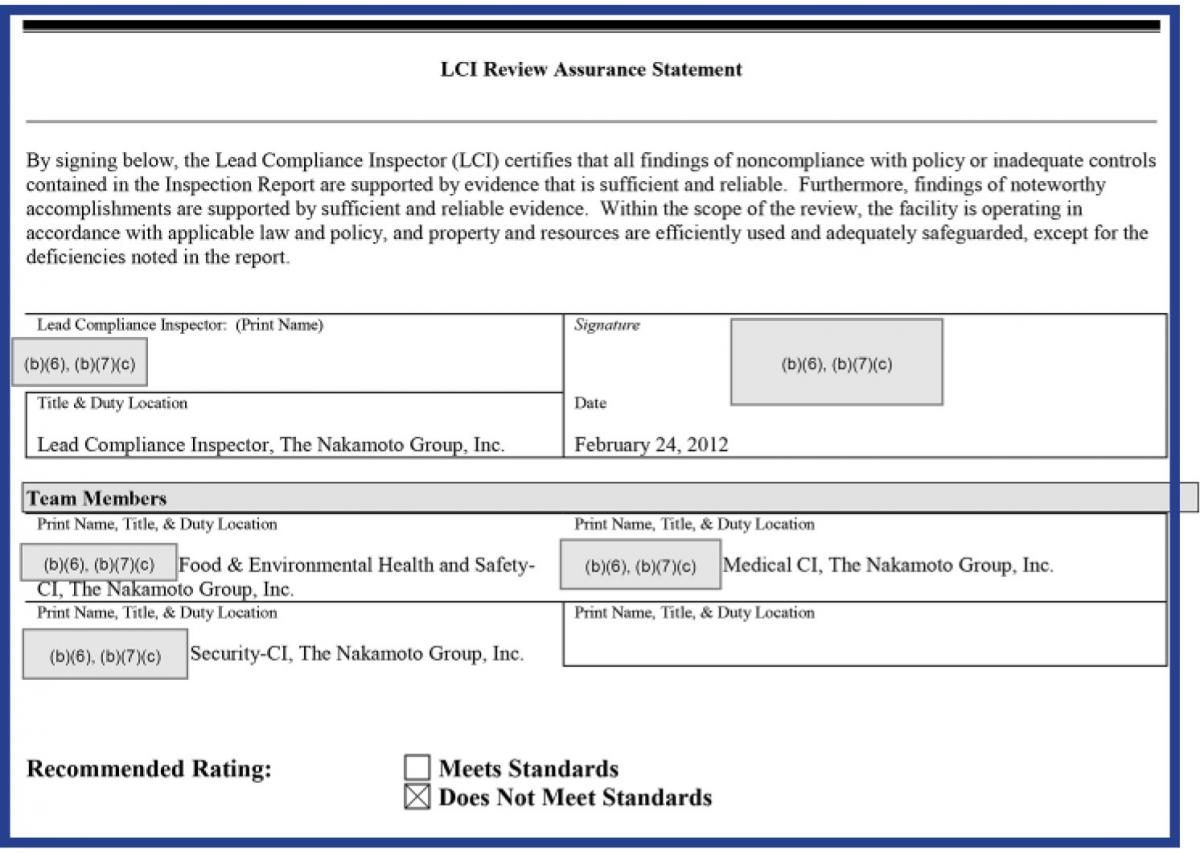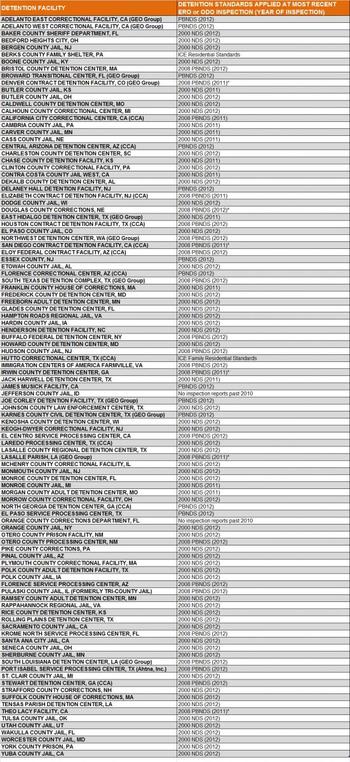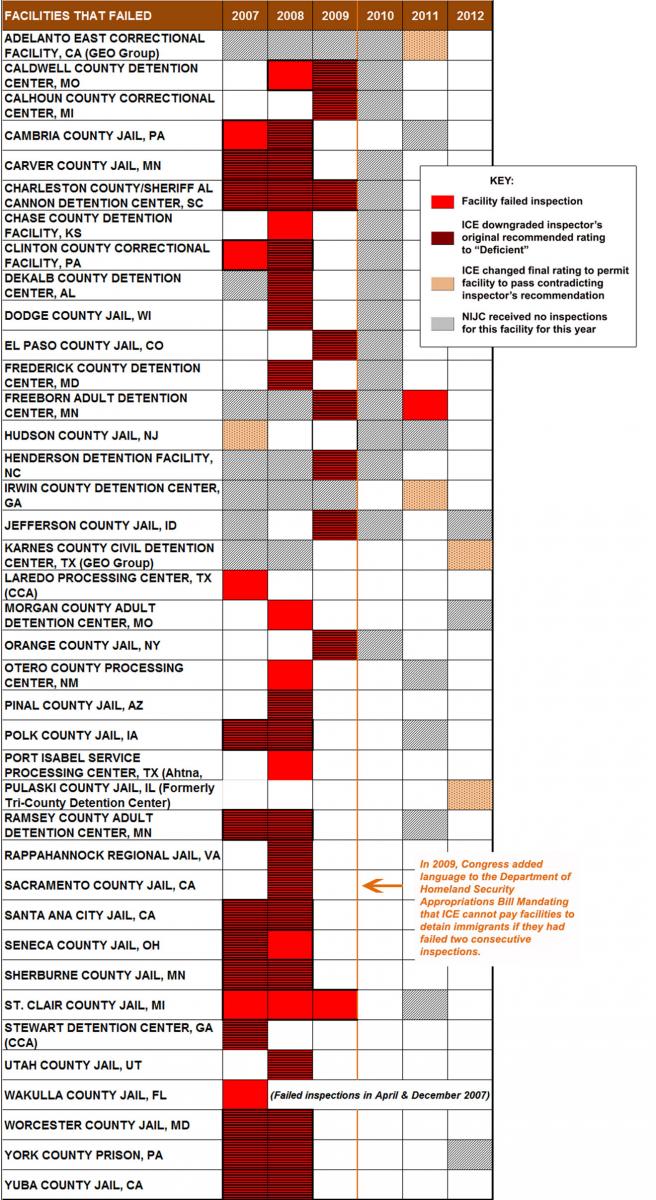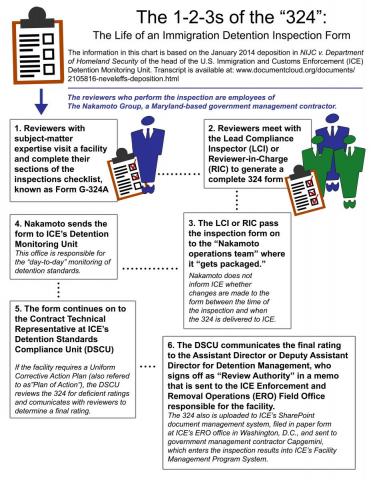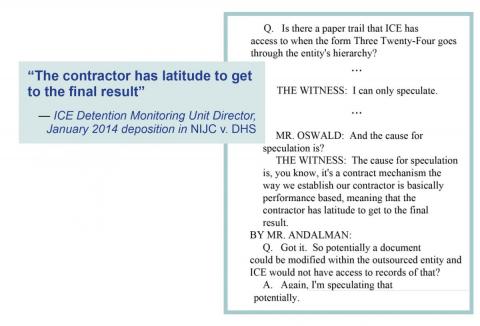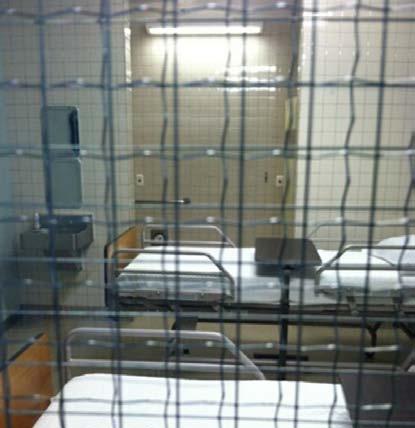The Immigration Detention Transparency and Human Rights Project
October 2015 Report
I. Executive Summary
In the aftermath of September 11, 2001, when the immigration detention system began its unprecedented growth, the world slowly began to hear about the troubling conditions of detention that immigrants confronted in government custody while facing removal from the United States. Years later, the Obama administration would inherit a sprawling, broken immigration detention system with little oversight or accountability. In 2015, as the Obama administration winds down, its early promises of immigration detention reform have failed to materialize. The U.S. Immigration and Customs Enforcement (ICE) immigration detention inspections process—a key target of the Obama administration’s reform plan—remains non-transparent and ineffective at identifying pervasive and troubling conditions in detention. Instead, the inspections process remains a “checklist culture,” in which inspectors—employed by ICE directly or via subcontracts—engage in pre-planned, perfunctory reviews of detention facilities that are designed to result in passing ratings and to ensure local counties and private prison corporations continue to receive government funds.
A review of five years of ICE inspections for 105 of the largest immigration detention centers confirms that ICE’s oversight practices under the Obama administration remain fundamentally unchanged and unreformed. Public and private contractors who run detention facilities continue to make money without adequate oversight, and troubling conditions of detention persist for the more than 400,000 individuals who pass through ICE custody each year. In fact, detailed reviews of six facilities known to have troubling human rights records suggest that in some cases, ICE inspections allow facilities to obscure severe conditions problems and their inability to protect the rights and lives of detained immigrants.
Immigration Detention Oversight Under the Obama Administration
 The transition from the Bush to the Obama administration was accompanied by a tide of high-profile reports by journalists and advocates chronicling human rights abuses and unexplained deaths of people in ICE custody. In groundbreaking exposés in 2008, both The Washington Post and The New York Times examined allegations of negligent medical care and revealed that at least 83 people had died in ICE custody between 2003 and 2008. That same year, a report about the Northwest Detention Center in Tacoma, Washington, described inadequate medical care and food, deplorable daily living conditions, and impediments to legal information—conditions similar to what individuals in ICE custody experienced around the country. In 2009, advocates published ICE detention documents obtained in litigation, and concluded that the inspections process had failed.
The transition from the Bush to the Obama administration was accompanied by a tide of high-profile reports by journalists and advocates chronicling human rights abuses and unexplained deaths of people in ICE custody. In groundbreaking exposés in 2008, both The Washington Post and The New York Times examined allegations of negligent medical care and revealed that at least 83 people had died in ICE custody between 2003 and 2008. That same year, a report about the Northwest Detention Center in Tacoma, Washington, described inadequate medical care and food, deplorable daily living conditions, and impediments to legal information—conditions similar to what individuals in ICE custody experienced around the country. In 2009, advocates published ICE detention documents obtained in litigation, and concluded that the inspections process had failed.
This public scrutiny prompted congressional inquiries into the sprawling system whose population had quadrupled within a span of 14 years. Congress passed a 2009 Department of Homeland Security (DHS) appropriations bill which included a provision that ICE cannot expend funds to immigration detention facilities that fail two consecutive inspections. On August 6, 2009, the Obama administration also responded by announcing a series of reforms which it said would create a more civil detention system. Among the reforms was a revamp of ICE’s compliance monitoring procedures and the establishment of the Office of Detention Oversight (ODO) to inspect immigration detention facilities and investigate the deaths of individuals in ICE custody.1
In addition to changes to the immigration detention system, in 2009 President Obama promised transparency across the federal government. On January 21, 2009, the president directed the heads of all federal agencies to “adopt a presumption in favor of disclosure … and to usher in a new era of open Government.” In a memorandum, he said, “The presumption of disclosure also means that agencies should take affirmative steps to make information public.” Nonetheless, such proactive transparency and commitment to open government failed to materialize in the immigration context. The ICE inspections regime is shrouded in secrecy. Information regarding facilities’ compliance with ICE’s detention standards has largely been hidden from the public. Since ICE released its first and only semiannual report on compliance with its national detention standards in 2007, information about how ICE oversees detention facilities, and what that oversight uncovered, has largely come from Freedom of Information Act (FOIA) requests and litigation. The inspections released with this report were not made available voluntarily by DHS, but as the result of FOIA requests by the National Immigrant Justice Center (NIJC) and a federal court order following three years of litigation.
NIJC has released all inspections from 2007 to 2012 obtained through the FOIA litigation at immigrantjustice.org/TransparencyandHumanRights.
Overview of Findings
NIJC and Detention Watch Network (DWN) reviewed ICE detention facility inspections dating from 2007 to 2012, most of which were previously unreleased. A close analysis of the inspections, along with additional human rights reports that elucidate conditions in specific facilities, reveals that the Obama administration has done little to improve oversight or gain control over the sprawling immigration detention system and the conditions approximately 34,000 immigrants face in custody every night.
The documents released include:
1. Annual facility inspections by the ICE Office of Enforcement and Removal Operations (ERO). Under the 2009 DHS Appropriations Act, these are the inspections that determine whether detention facilities are allowed to maintain their contracts with ICE.
2. Facility inspections by the ODO, the office under the ICE Office of Professional Responsibility purportedly created to ensure better monitoring compliance.2
3. The deposition of the chief of ICE’s Detention Monitoring Unit, which provides an overview of the immigration detention inspections process.
This report contains an evaluation of the ERO and ODO inspections process itself as gleaned from the documents and a focused analysis of six detention facilities known to have detention conditions violations during the study period.
While the most recent inspections covered in this report are from 2012, there is no indication that any of the shortcomings identified have changed. Three years later, advocates and non-governmental organizations (NGOs) continue to raise complaints of systemic human rights and due process violations in the immigration detention system. In the first nine months of 2015 alone, ICE reported six deaths in detention.
Based on the review of the inspection reports, NIJC and DWN found:
1. ICE’s Culture of Secrecy Persists
- Neither information nor documents which would help the public to understand ICE’s inspections and oversight processes are readily available.
- There is a lack of independent oversight because both entities which conduct inspections are paid and vetted—either through contracts or as direct employees—by ICE.
2. ICE Inspections Fail to Adequately Assess the Conditions Detained Immigrants Experience
- Both ERO and ODO inform facilities of inspections in advance.3
- There are significant inconsistencies within and between inspection reports for individual facilities, as well as between ODO and ERO inspections, raising questions about the reliability of either inspections process.
- As of FY 2012, most ICE detention facilities continued to be inspected using outdated standards.
- Inspectors fail to apply 2008 and 2011 Performance-Based National Detention Standards language that was intended to improve oversight of facilities that detain immigrants for ICE under contracts called Intergovernmental Service Agreements (IGSAs).
- ERO and ODO inspection reports are not designed to capture actual conditions of detention for the population at a given facility.
3. Inspections are Designed to Facilitate Passing Ratings for Facilities, Not Identify or Address Violations
- Even where human rights violations and unexplained deaths have been publicly documented, facilities rarely fail ERO inspections.
- Inspection reports may be edited before they are finalized and submitted to ICE’s Detention Monitoring Unit by the inspections contractor.
- The checklist ERO inspectors use during their reviews does not include all components of the detention standards.
Recommendations
NIJC and DWN call on DHS and ICE to:
1. Increase Transparency and Oversight of the Inspections Process
A. Make ERO and ODO inspections available to the public in a timely manner. To date, ICE has released its inspections to the public only as a result of FOIA requests. FOIA requests are unnecessarily time-consuming and expensive obstacles to accessing information about how the federal government treats thousands of people in its custody and spends billions of taxpayer dollars. Instead, this information should be freely available.
B. Provide public reporting on suicide attempts, hunger strikes, work program stoppages, use of solitary confinement, use of force, and other significant events at detention centers.
C. Submit quarterly reporting to Congress on inspection and oversight activities of detention facilities, to be made available to the public.
2. Improve the Quality of Inspections
A. Establish a DHS ombudsman outside of ICE to conduct unannounced inspections of immigration detention facilities at least once per year, with complete findings made available to the public. These third-party inspections should examine compliance with applicable detention standards and determine whether contracts will be renewed in accordance with congressional appropriations requirements.
B. Prohibit facilities from taking an “à la carte” approach to compliance and make all detention standards provisions mandatory during inspections. ICE must stop permitting some facilities to opt out of detention standards they have been contracted to apply. If a facility cannot abide by detention standards in their entirety then it should not be permitted to enter into or continue a contract with ICE.
C. Ensure that inspections involve more than checklists. Inspectors must rely on more than assurances by jail administrators of compliance with detention standards and instead seek and document proof of their effective implementation.
D. Engage detained immigrants during inspections, as well as other stakeholders such as legal service providers and those who regularly conduct visitation, in order to capture the range of concerns at a facility that may not be reported through formal institutional channels. Inspectors should document the content of those interviews.
A. Place detention facilities on probation and subject them to more intensive inspections after the first finding of substantial non-compliance.
B. Terminate contracts within 60 days for those facilities with repeat findings of substantial non-compliance, including inadequate or less than the equivalent median score in two consecutive inspections.
II. Navigating the Inspection Reports
Each immigration detention facility is inspected according to a specific set of detention standards promulgated by ICE. Currently, three sets of detention standards primarily are in use: the 2000 National Detention Standards (NDS) and the Performance-Based National Detention Standards (PBNDS) issued in 2008 and 2011.4
Fig. 1: Inspection checklist excerpt from Eloy Federal Contract Facility 2012 ERO inspection |
Even when facilities are inspected according to the same set of standards, the type of contract each facility holds determines exactly which specific requirements of each standard (called “components” on the inspection worksheets, see Fig. 1) apply during an inspection. Facilities run by local governments, which ICE contracts through Intergovernmental Service Agreements (IGSAs), are permitted to adapt certain components.5 If a local government contractor subcontracts a jail’s operations to a private prison company, that company retains the ability to establish alternatives to some components.6 In contrast, Service Processing Centers (or SPCs, facilities owned and operated by ICE) and Contract Detention Facilities (or CDFs, those owned and operated by private companies) are not allowed such loopholes.
While the PBNDS contain more robust protections for detained immigrants, the ICE inspections process does not apply the same weight to all standards. Both the 2008 and 2011 PBNDS inspections checklists designate some components as “mandatory.” (See Fig. 1) For example, the 2008 PBNDS checklist includes 41 standards, which are broken down into a total of 889 components. Only 40 of these components are labeled “mandatory.” The introduction to the inspection form explains that mandatory items “typically represent life safety issues. A ‘Does Not Meet Standards’ on one of these components is very serious.”7 Failure to meet any mandatory component will cause the facility to receive an overall deficient rating. But ICE only takes a small number of these components so seriously. Some critical components, such as those covering facilities’ response to hunger strikes or guaranteeing detained individuals have 24-hour access to emergency care, are not marked as mandatory. Many of these mandatory components ensure that there are written policies and plans in place for emergencies, but they do not reflect or even check for implementation. As much as the standards were purported to be written “with a focus on the results or outcomes that the required procedures are expected to accomplish,”8 there remains a gap in truly evaluating efficacy.
There are three types of inspections:
1. ERO Inspections
Facilities that hold 50 or more people are subject to inspections conducted by ERO’s Detention Management Division. The ERO inspections are conducted by private contractors on an annual basis.9 Inspectors use a checklist of applicable national detention standards and each standard’s components (ICE Form G-324A). The ERO ratings system consists of three tiers: the components of each standard receive ratings, which determine the rating for each standard, which in turn inform the overall rating for the facility. (See Figs. 2-4) Facilities inspected under the 2008 and 2011 PBNDS are rated simply as “meets standards” or “does not meet standards.” Facilities inspected under the 2000 NDS can be rated “superior,” “good,” “acceptable,” “deficient,” or “at risk.” There is space for notes next to each of the components and for concluding remarks to summarize the full inspection, but the quality of comments varies greatly from inspector to inspector.
2. ODO Inspections
Facilities with average daily populations of 50 or more people may also be subject to ODO inspections. ODO inspectors, who may be ICE employees or contractors, focus on key standards which have been identified as areas where a facility may not be in compliance. For their inspections, the ODO inspectors collect and analyze “relevant allegations, complaints and detainee information from multiple ICE databases”10 and gather “facility facts and inspection-related information from ERO [headquarters] staff to prepare for the site visit.”11
3. Self Assessments:
Facilities that only hold immigrants for less than 72 hours at a time, or that hold 10 or fewer immigrants for more than 72 hours, are subject only to the Organizational Review Self-Assessment (ORSA) process. ORSA inspections were not included in NIJC’s FOIA litigation, which focused on the largest 100 immigration detention facilities.
Fig. 2: First tier to the ERO checklist is a rating of individual components within a given standard. |
|
Fig. 3: Second tier to the ERO checklist is a rating for an overall standard, which is based on the ratings of individual components. |
|
Fig. 4: Third tier to the ERO checklist is a rating for the overall facility, which is based on the ratings given to standards.
Excerpts from Tri-County Detention Center (now Pulaski County Jail) 2012 ERO inspection. |
III. Ineffective Inspections
Why ICE Inspections Matter
ICE’s ERO inspections generate the ratings that determine, under DHS Appropriations Act requirements, whether the government continues funding a local government or private entity to detain immigrants. As early as 2007, Congress expressed concerns about the lack of compliance with detention standards in facilities managed by ICE as well as contractors, and directed ICE to improve the quality and frequency of oversight.12 One year later, Congress added specific language to the FY 2009 DHS appropriations law prohibiting ICE from expending funds to facilities that are found deficient in two consecutive inspections. That bill stated:
Provided further, That effective April 15, 2009, none of the funds provided under this heading may be used to continue any contract for the provision of detention services if the two most recent overall performance evaluations received by the contracted facility are less than ‘‘adequate’’ or the equivalent median score in any subsequent performance evaluation system.13
This mandate signaled congressional intent that immigration detention facilities be monitored for adherence to humane standards of detention, and ICE subsequently acknowledged its understanding of this obligation. According to 2010 congressional testimony by former ICE Director John Morton, eight facilities had been closed because they had failed to achieve acceptable ratings. However, because ICE does not share information publicly about which facilities it uses or contracts with at any given time, it is unknown which facilities Director Morton was referring to or how many additional facilities, if any, have since had contracts terminated on the basis of failure to meet adequate standards. This lack of transparency makes it difficult for taxpayers or members of Congress to ascertain whether ICE is indeed adhering to the intent encompassed in the Appropriations Act language. Further, passing ratings based on cursory checklists cannot be what Congress intended as a condition for expending taxpayer money to subsidize the detention of immigrants.
Findings Regarding the ERO and ODO Inspections Process:
1. ICE’s Culture of Secrecy Persists
- Neither information nor documents which would help the public to understand ICE’s inspections and oversight processes are readily available. ICE does not publicly post inspection reports as a matter of practice. Rather, it took years of resource-intensive litigation for NIJC to obtain inspection reports. This record undermines President Obama’s early promises of open government.
- There is a lack of independent oversight because both entities which conduct inspections are paid and vetted—either through contracts or as direct employees—by ICE. The ODO is housed within ICE’s Office of Professional Responsibility, and ERO inspectors are employed by private companies contracted by ICE. While government agencies routinely are permitted to keep themselves accountable, the problems apparent in the inspections reviewed for this report show this is not sound practice, especially within the detention system which has been persistently plagued by sub-standard conditions and frequent reports of abuse.
2. ICE Inspections Fail to Adequately Assess the Conditions Detained Immigrants Experience
- Both ERO and ODO inform facilities of inspections in advance.14 This warning provides ample time for facilities to prepare and “clean up” before inspectors arrive, seriously hampering the ability of inspectors to make honest and accurate assessment of the typical conditions under which detained individuals are held on a typical day.
- There are significant inconsistencies within and between inspection reports for individual facilities, as well as between ODO and ERO inspections, raising questions about the reliability of either inspections process. Such inconsistencies were identified for all five facilities for which DWN and NIJC conducted in-depth reviews of 2011 and 2012 ERO and ODO inspections (the sixth facility reviewed in this report has never been inspected by ODO). In October 2014, the Government Accountability Office (GAO) released a report criticizing the variation between inspections carried out by ERO and ODO during roughly the same time period for the same facilities. Out of 35 facilities inspected by both ERO and ODO in fiscal year 2013, the findings between the two entities differed substantially for 29 facilities. The GAO’s findings substantiate those which NIJC and DWN found in 2011 and 2012 inspections, and bring into question the credibility of the entire review system. The ERO and ODO inspections consistently fail to account for or acknowledge egregious human rights concerns raised in independent reports published by NGOs.
-
Fig. 5: Standards applied for most recent inspection obtained
Fig. 6: Failed inspections, 2007-2012
As of FY 2012, most ICE detention facilities continued to be inspected using outdated standards. (See Fig. 5) Sixty-five of the 103 detention facilities for which NIJC obtained 2012 or 2011 inspections were still inspected against the least-rigorous 2000 NDS. Thirty percent of the population represented by the 84 inspections NIJC obtained for FY 2012 were in facilities still being inspected under 2000 NDS. Even the GAO, in its 2014 report, requested clarity regarding why ICE continued to contract with facilities operating on a decade-old set of standards. Not only are the 2000 NDS irrelevant to the times, they are also largely irrelevant to the needs of detained individuals. In fact, one of the 2000 NDS states that a facility is in compliance if the law library is adequately equipped with typewriters. Nonetheless, while the 2008 and 2011 PBNDS contain more robust protections than the 2000 NDS, including sexual assault prevention guidelines and more detailed standards governing solitary confinement and hunger strike response, they too are problematic. Like the 2000 NDS, the PBNDS are derived from prison standards created within the criminal justice context, and therefore replicate many of the deplorable conditions and troubling human rights failings endemic to that system.
- Inspectors fail to apply 2008 and 2011 PBNDS language that was intended to improve oversight. The inspection form for the 2000 NDS states that some components are applicable only to Service Processing Centers and Contract Detention Facilities. IGSAs, which hold the majority of detained immigrants, are encouraged to use these components as guidelines but are not rated on them. For example, in IGSA facilities under the 2000 NDS, people placed in solitary confinement do not have a right to appeal that decision and their placement is not reviewed regularly by a supervisory agent. Within these facilities, medical staff are not required to conduct daily check-ins with people on hunger strikes. Even under 2008 PBNDS guards may read incoming mail without a warden’s prior written approval and out of the detained individual’s presence. This practice threatens attorney-client confidentiality and can make the difference in whether or not detained individuals can safely report complaints to their attorneys and seek redress without facing retribution. Language holding IGSAs to higher standards was strengthened in the 2008 and 2011 PBNDS to require IGSAs to “adopt, adapt, or establish alternatives, provided they meet or exceed the intent represented by these procedures,” but many inspectors continue to mark these components as “not applicable” for IGSAs being inspected under the PBNDS. The PBNDS were written to strengthen protections for immigrants detained at IGSAs, but inspectors have failed to uphold that intent.
- ERO and ODO inspection reports are not designed to capture actual conditions of detention for the population at a given facility. While there is an emphasis in both ERO and ODO inspections on the security of a facility and ensuring that detained individuals stay locked up, there is a de-emphasis on the humane treatment and protection of people imprisoned for their immigration status. As focused reviews of inspections at six detention facilities revealed (see Section IV), inspectors track whether or not policies exist rather than inquire into their implementation or effectiveness. Inspectors often take facility administrators at their word regarding issues such as the adequacy of medical staff, the efficacy of grievance procedures, or even basic and easily verifiable safety mechanisms such as whether fire alarms are functional. The checklist-driven inspections process obscures the conditions immigrants actually face in detention centers and whether standards are being implemented to their full intent. Even when critical aspects are included in the standards, they often are segmented into sterile lists of mundane details that are easy to check off because they do not immediately appear to be connected to anything important. For example, all three sets of detention standards include guidelines for telephone access, but are extremely limited in their provision of free phone calls. They fail to acknowledge that in many facilities, the high cost of telephone calls inhibit individuals’ ability to communicate with lawyers, family, and other support systems. Telephone contact is critical to preserve due process and prevent isolation, but the inspections process provides no means for inspectors to document or even detect the financial hurdles that block immigrants from making calls in some facilities. ERO inspections rarely cite interviews with individuals in custody, and ODO inspections treat such interviews as footnotes. Therefore inspectors are able to check that a facility meets standards because “No restrictions are placed on detainees attempting to contact attorneys and legal service providers who are on the approved ‘Free Legal Services List,’” even when a short conversation with the detained immigrants who have tried to use those phones would reveal otherwise. The checklist culture also leads to absurd interpretations of standards, a reality perhaps best demonstrated by the repeat finding that indoor rooms with windows count as providing outdoor recreation because air from the outside can enter the room.
3. Inspections Prioritize Facilities’ Interests
-
Even where human rights violations have been publicly documented, facilities rarely fail ERO inspections. (See Fig. 6 and Section IV) The number of failed facilities dropped significantly since 2009, when Congress implemented the appropriations requirement that ICE not expend funds to facilities with two consecutive failed inspections. No detention centers failed ERO inspections in 2010 or 2012, and only four failed in 2011. ICE has not failed any facility twice in a row since the 2009 law took effect.
-
Inspection reports may be edited before they are finalized and submitted to ICE’s Detention Monitoring Unit by the inspections contractor. The ICE Detention Services Management director explained during his litigation deposition that both inspections contractors and ICE personnel may edit the findings and ratings in a report before it is submitted to the facility’s file. These edits are not tracked, and ICE has no knowledge of the frequency or types of edits that occur between an initial inspection and when the inspections contractor submits the inspection report.
-
The checklist ERO inspectors use during their reviews does not include all components of the detention standards. As the focused review of inspections from Arizona’s Eloy Detention Center reveals (see Section IV), such discrepancies could obscure important details of daily operations, such as medical care staffing, which are critical to ensuring detained immigrants’ basic human rights.
IV. In Focus: Six Case Studies of Facilities with Known Conditions Problems, 2007-2012
The peculiarities and efficacy of the ICE inspections system are best understood through a focused review of facilities where human rights and due process conditions have been publicly documented, providing a basis for comparison with inspectors’ observations. For this deep-dive approach, DWN and NIJC selected six detention centers which have been subjects of media reports, human rights investigations, and congressional inquiries. All but Eloy were included in DWN’s 2012 Expose & Close (E&C) reports which surveyed immigrants detained at some of the worst immigration detention facilities in the United States.
- Eloy Federal Contract Facility, Arizona
- Baker County Detention Center, Florida
- Etowah County Detention Center, Alabama
- Houston Processing Center, Texas
- Stewart Detention Center, Georgia
- Pulaski County Jail, Illinois (formerly named Tri-County Detention Center)
V. Conclusion and Recommendations
These six case studies demonstrate that the ICE inspections system is inadequate and has failed to resolve the substantial and pervasive human rights violations detained immigrants face in ICE custody. In many cases, the poor conditions and mistreatment individuals suffer are explicitly prohibited under ICE detention standards. Instead of reporting on these violations, the inspectors focus on completing checklists and fail to engage with detained immigrants or follow up on issues raised in public reports. It is easy for facilities to pass inspections without actually upholding the standards’ intent.
According to the 2009 congressional mandate, the ICE inspections process creates a threshold which determines whether or not ICE can continue to contract with local governments and private prison companies to run immigration detention facilities. Unfortunately, NIJC and DWN found that ICE’s inspections mechanisms whitewash problems and ensure that even the worst detention facilities pass inspections and maintain contracts. Without a credible system of oversight, there is no humane way to incarcerate immigrants.
Based on the findings of this report, NIJC and DWN call on DHS and ICE to:
1. Increase Transparency and Oversight of the Inspections Process
A. Make ERO and ODO inspections available to the public in a timely manner. To date, ICE has released its inspections to the public only as a result of FOIA requests. FOIA requests are unnecessarily time-consuming and expensive obstacles to accessing information about how the federal government treats thousands of people in its custody and spends billions of taxpayer dollars. Instead, this information should be freely available.
B. Provide public reporting on suicide attempts, hunger strikes, work program stoppages, use of solitary confinement, use of force, and other significant events at detention centers.
C. Submit quarterly reporting to Congress on inspection and oversight activities of detention facilities, which should be made publicly available.
2. Improve the Quality of Inspections
A. Establish a DHS ombudsman outside of ICE to conduct unannounced inspections of immigration detention facilities at least once per year, with complete findings made available to the public. These third-party inspections should examine compliance with applicable detention standards and determine whether contracts will be renewed in accordance with congressional appropriations requirements.
B. Prohibit facilities from taking an “à la carte” approach to compliance and make all detention standards provisions mandatory during inspections. ICE must stop permitting some facilities to opt out of detention standards they have been contracted to apply. If a facility cannot abide by detention standards in their entirety then it should not be permitted to enter into or continue a contract with ICE.
C. Ensure that inspections involve more than checklists. Inspectors must rely on more than assurances by jail administrators of compliance with detention standards and instead seek and document proof of their effective implementation.
D. Engage detained immigrants during inspections, as well as other stakeholders such as legal service providers and those who regularly conduct visitation, in order to capture the range of concerns at a facility that may not be reported through formal institutional channels. Inspectors should document the content of those interviews.
3. Institute Consequences for Failed Inspections
A. Place detention facilities on probation and subject them to more intensive inspections after the first finding of substantial non-compliance.
B. Terminate contracts within 60 days for those facilities with repeat findings of substantial non-compliance, including inadequate or less than the equivalent median score in two consecutive inspections.
VI. Acknowledgments
This report was a collaborative effort of NIJC and DWN. Primary contributors were: Claudia Valenzuela, Tara Tidwell Cullen, Jennifer Chan, and Royce Bernstein Murray of NIJC; and Mary Small, Carol Wu, and Silky Shah of DWN. Additional thanks to Assistant Professor John Eason, Professor Pat Rubio Goldsmith, and their team at the Texas A&M Department of Sociology and Professor David Hernández at Mount Holyoke College whose review of thousands of pages of documents and feedback were critical to this report. NIJC staff and interns also contributed crucial research, editing, and design support: Mark Fleming, Catherine Matthews, Mary Meg McCarthy, Kathleen O’Donovan, Katherine Rivera, and Julia Toepfer. Sincere thanks to pro bono attorneys at Dentons US LLP, who represented NIJC through more than three years of Freedom of Information Act litigation to obtain the inspections documents analyzed for this report.


